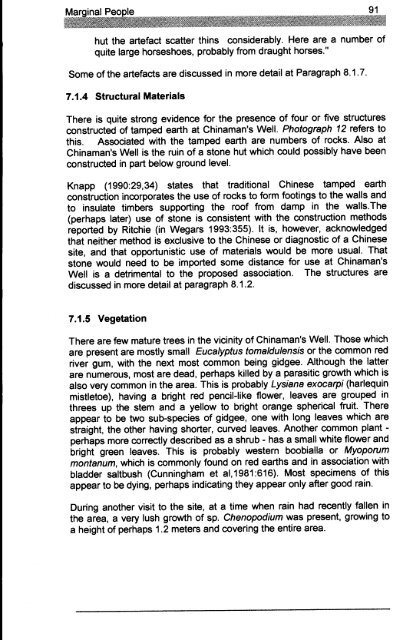Adec Preview Generated PDF File - The Sydney eScholarship ...
Adec Preview Generated PDF File - The Sydney eScholarship ...
Adec Preview Generated PDF File - The Sydney eScholarship ...
You also want an ePaper? Increase the reach of your titles
YUMPU automatically turns print PDFs into web optimized ePapers that Google loves.
hut the artefact scatter thins considerably. Here are a number of<br />
quite large horseshoes, probably from draught horses. fI<br />
Some of the artefacts are discussed in more detail at Paragraph 8.1.7.<br />
7.1.4 Structural Materials<br />
<strong>The</strong>re is quite strong evidence for the presence of four or five structures<br />
constructed of tamped earth at Chinaman's Well. Photograph 12 refers to<br />
this. Associated with the tamped earth are numbers of rocks. Also at<br />
Chinaman's Well is the ruin of a stone hut which could possibly have been<br />
constructed in part below ground level.<br />
Knapp (1990:29,34) states that traditional Chinese tamped earth<br />
construction incorporates the use of rocks to form footings to the walls and<br />
to insulate timbers supporting the roof from damp in the walls.<strong>The</strong><br />
(perhaps later) use of stone is consistent with the construction methods<br />
reported by Ritchie (in Wegars 1993:355). It is, however, acknowledged<br />
that neither method is exclusive to the Chinese or diagnostic of a Chinese<br />
site, and that opportunistic use of materials would be more usual. That<br />
stone would need to be imported some distance for use at Chinaman's<br />
Well is a detrimental to the proposed association. <strong>The</strong> structures are<br />
discussed in more detail at paragraph 8.1.2.<br />
7.1.5 Vegetation<br />
<strong>The</strong>re are few mature trees in the vicinity of Chinaman's Well. Those which<br />
are present are mostly small Eucalyptus tomaldulensis or the common red<br />
river gum, with the next most common being gidgee. Although the latter<br />
are numerous, most are dead, perhaps killed by a parasitic growth which is<br />
also very common in the area. This is probably Lysiana exocarpi (harlequin<br />
mistletoe), having a bright red pencil-like flower, leaves are grouped in<br />
threes up the stem and a yellow to bright orange spherical fruit. <strong>The</strong>re<br />
appear to be two sub-species of gidgee, one with long leaves which are<br />
straight, the other having shorter, curved leaves. Another common plant <br />
perhaps more correctly described as a shrub - has a small white flower and<br />
bright green leaves. This is probably western boobialla or Myoporum<br />
montanum, which is commonly found on red earths and in association with<br />
bladder saltbush (Cunningham et ai, 1981 :616). Most specimens of this<br />
appear to be dying, perhaps indicating they appear only after good rain.<br />
During another visit to the site, at a time when rain had recently fallen in<br />
the area, a very lush growth of sp. Chenopodium was present, growing to<br />
a height of perhaps 1.2 meters and covering the entire area.




